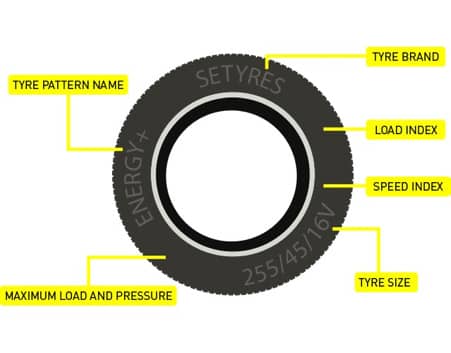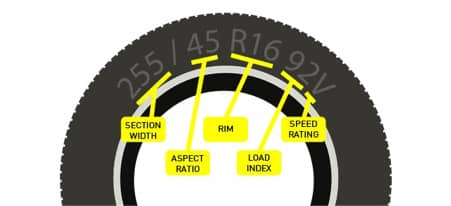How to Read your Tyre Sidewall Markings
The information printed around the sidewall of your tyre can tell you everything you need to know about your tyres. This information, however, is fairly difficult to read as it is mostly written in symbols, shorthand and codes. Fortunately, Setyres are on hand to help and we’ve compiled a guide to help you learn what your tyre sidewall markings mean and how important they are for you as a driver.
Tyre sidewall markings are predominantly used for two reasons. Firstly, they indicate the size and specification of the tyre and secondly, they indicate that the tyre has passed the necessary standards required to make it road safe and legal.

Tyre Brand
The manufacturer of the tyre will be clearly identifiable on the tyre sidewall.
Tyre Pattern Name
All tyre manufacturers have a range of tread patterns unique to their brand. The name given to the pattern of your tyre will be printed on the sidewall and often the range that your tyre has come from. This can be useful if you needed to replace your tyre and wanted to find a similar or identical tyre to replace it with.
Maximum Pressure
This figure indicates the maximum pressure that the tyre can withstand. You must not confuse this with the recommended inflation pressure suitable for every day driving. For more information on finding this figure, take a look at our advice about tyre pressure.

Tyre Size
The size of the tyre is clearly printed along the tyre sidewall as a string of numbers. It will look something like this: 205/55/R18 105V. This indicates the sizes and dimensions of the tyre.
205 is the tyre width in millimetres.
55 indicates the tyre sidewall height as a percentage.
R stands for radial construction.
18 displays the nominal diameter of the wheel rim that the tyre is designed to fit in inches.
Load Index
The load index is displayed following the string of numbers which are used to identify the sizes of the tyre: 205/55/R18 105V. This is a numerical code and relates to an amount in kilometres. The table below displays the load amounts that the codes indicate.
| Load Index | Kilograms | Load Index | Kilograms | Load Index | Kilograms |
|---|---|---|---|---|---|
| 65 | 290 | 80 | 450 | 95 | 690 |
| 66 | 300 | 81 | 462 | 96 | 710 |
| 67 | 307 | 82 | 475 | 97 | 730 |
| 68 | 315 | 83 | 487 | 98 | 750 |
| 69 | 325 | 84 | 500 | 99 | 775 |
| 70 | 335 | 85 | 515 | 100 | 800 |
| 71 | 345 | 86 | 530 | 101 | 825 |
| 72 | 355 | 87 | 545 | 102 | 850 |
| 73 | 365 | 88 | 560 | 103 | 875 |
| 74 | 375 | 89 | 580 | 104 | 900 |
| 75 | 387 | 90 | 600 | 105 | 925 |
| 76 | 400 | 91 | 615 | 106 | 950 |
| 77 | 412 | 92 | 630 | 107 | 975 |
| 78 | 425 | 93 | 650 | 108 | 1000 |
| 79 | 437 | 94 | 670 |
Speed Index
The speed index can be found after the load index on the tyre here 205/55/R18 105V. This letter indicates the maximum speed that the tyre can service and can be identified within the following table.
| Speed Symbol | Approx MPH |
|---|---|
| Q | 99 |
| R | 106 |
| S | 112 |
| T | 118 |
| H | 131 |
| V | 149 |
| VR | 131 |
| W | 168 |
| Y | 186 |
| ZR | 149 |
Tread Wear Indicator
Tread wear indicators are present on many, but not all, tyres. The location of these indicators are highlighted by the letters TWI, except for on Michelin tyres which use the image of the Michelin man. The indicator will be set to at least 1.6mm, the minimum legal tread depth in the UK. When your tyre tread wears to reveal your tread wear indicator then it means you must have your tyres replaced. This is an emergency procedure and you should regularly check your tread depth to ensure that they do not drop too low. Take a look at how to check your tread depth here.
Mounting Direction
Tyre sidewalls are usually marked clearly with an indicator to show which way they should be mounted to the vehicle. This is because tyre tread and block have usually been designed to perform when travelling in a certain direction. Fitting tyres against the way that they were designed can lead to MOT failure.
European EC Type Approval Marks
The ‘EC’ marking proves that the tyre has been tested to European safety standards and has been approved. The ‘S’ symbol indicates sound and means that the tyre complies with EC noise directive.
If you have any questions regarding the symbols on your tyres or if you’re looking to buy new tyres, simply contact or visit your nearest Setyres branch.